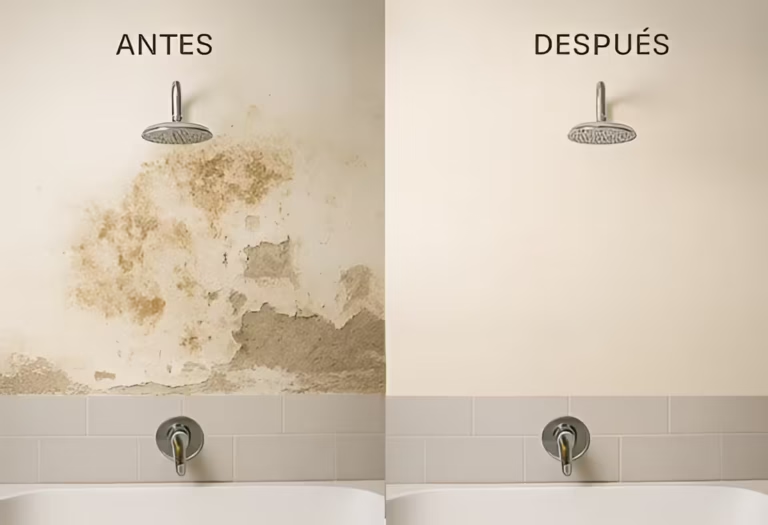Moisture is one of the most common problems affecting exterior and interior walls. It affects aesthetics, causing stains and flaking, and also compromises the health of the people living inside the homes.
The most important thing in finding and choosing the best solution is to find and understand the source of the moisture: rain seeping into a facade is not the same as moisture rising from the ground or water pressure in a basement.
Rain moisture on facades
Facades are the first line of defense for buildings. Rain, especially when combined with wind, can penetrate the pores of the cladding and cause stains, spalling, and color loss.
The key is to use coatings that are impermeable to rainwater but permeable to vapor, allowing the wall to “breathe.”
Washed-plaster mortars or single-layer scraped mortars are systems that guarantee dry facades with a firm finish for years to come.
Moisture from the ground
It is also common to find dampness coming up from the ground to the façade. This is known as capillary dampness. It causes flaking, saltpeter stains, and deterioration of the plaster.
The solution involves using breathable, waterproof mortars that promote the evaporation of water contained in the wall, preventing moisture accumulation and salt stains.
An example of these mortars are lime mortars, ideal for renovating baseboards and walls in contact with the ground.
Moisture in interior walls
On interior walls, damp problems manifest themselves in the form of mold, unpleasant odors, peeling paint, and a harmful environment. These problems go beyond aesthetics and can affect people’s health.
This type of humidity is due to two factors:
- Walls that do not breathe: Walls covered with paints or mortars that are too compact block the natural escape of vapor.
- Excessive humidity. Condensation accumulates on the walls, causing mold to grow, especially in corners.
Para solucionarlo, la mejor opción es devolverle al muro su capacidad de transpiración para que pueda evacuar el vapor y no se acumule formando manchas.
Los morteros de cal transpirable e impermeable son la mejor opción, ya que gracias a la naturaleza porosa de la cal, permite que el vapor de agua atraviese la pared y se disipe, a la vez que protege la superficie frente a filtraciones puntuales. A diferencia de los revestimientos plásticos o cementosos tradicionales, no encierra la humedad en el muro, sino que la regula, favoreciendo un ambiente interior más saludable.
The use of lime mortars is particularly recommended for renovating old houses, basements with natural ventilation, stone or brick walls showing efflorescence, and even for interior renovations where a more natural and durable finish is desired. In addition, lime has bactericidal and fungicidal properties, which help prevent mold growth in areas prone to condensation.
Applying a breathable system like this not only solves the problem of humidity, but also improves comfort and indoor air quality, avoiding frequent repainting and ensuring the durability of the coating.
Dampness in bathrooms
Although they are also interior walls, bathroom walls deserve special mention. They require special protection against water because they are exposed to it more frequently and the wall or partition is more sensitive (hollow brick, thin plaster).
The best option for this type of surface is to apply cementitious waterproofing mortars, designed to protect interior and/or exterior walls from the effects of water and moisture. They are perfect for bathrooms, showers, facades with thin plaster, and ceramic partitions, where maximum waterproofing is needed in reduced thicknesses.
Moisture in areas exposed to water: balconies, terraces, and swimming pools
En zonas en contacto directo con el agua, la posibilidad de que aparezcan humedades es mayor. Tanto la lluvia como la acumulación del agua o los cambios de temperatura generan microfisuras en suelos o paredes que producen humedades.
On balconies, terraces, decks, or swimming pools, the best solution is to apply flexible waterproofing mortars, specially designed for contact with water, which adapt to small cracks or movements.
These mortars create a watertight barrier, perfect for outdoor areas that are constantly in contact with water.
Moisture in basements or garages
This dampness appears due to pressure from groundwater. It affects basement walls, garages, elevator shafts, and retaining walls, causing mold, leaks, and loss of structural strength.
This dampness appears due to pressure from groundwater. It affects basement walls, garages, elevator shafts, and retaining walls, causing mold, leaks, and loss of structural strength.
Solution for treating damp walls
As we have seen, there is no single solution for treating damp walls, as not all types of damp are the same. Rain, indoor condensation, water pressure, and capillarity all influence the best solution for treating damp in your walls.
At Pavicret, we have developed a range of mortars and waterproofing products for every type of moisture problem, allowing us to effectively treat each issue, both on interior and exterior walls.
If you need help determining the best system to prevent dampness in your construction, renovation, or restoration project, please contact us.
Our technical team will advise you step by step to choose the right product and guarantee a professional result.

